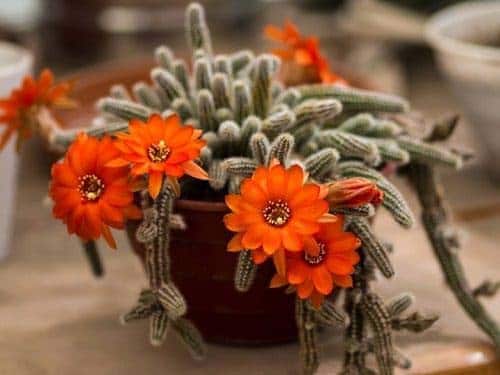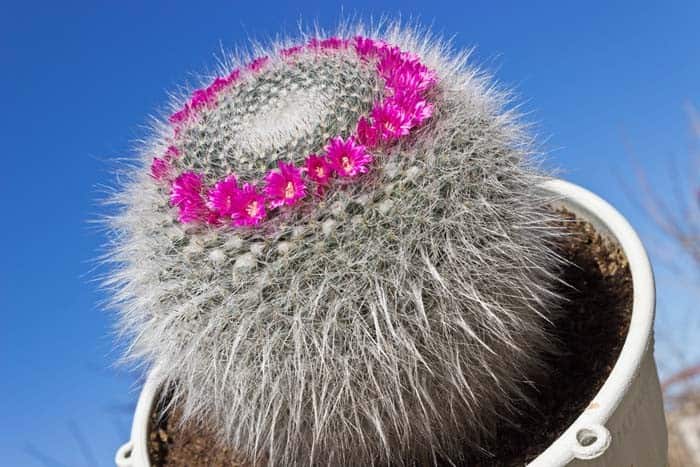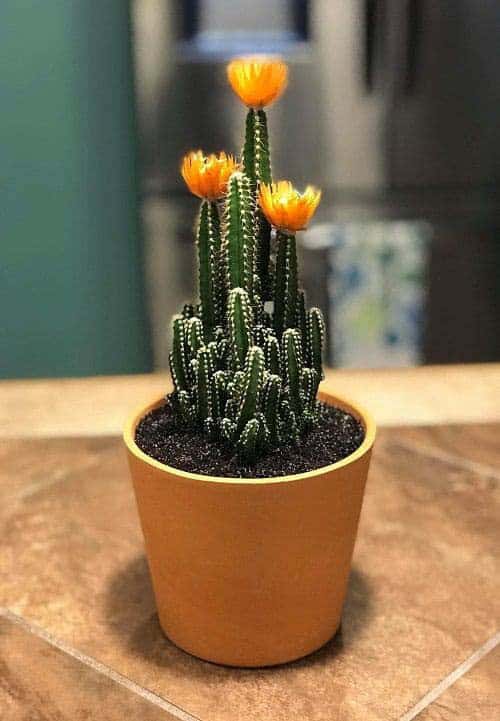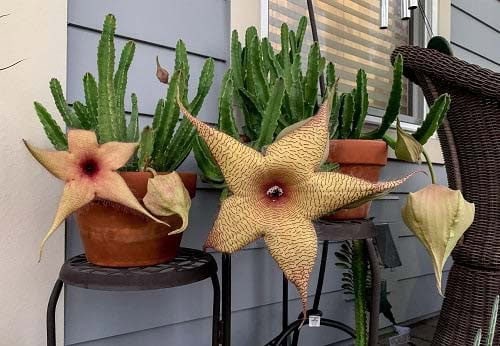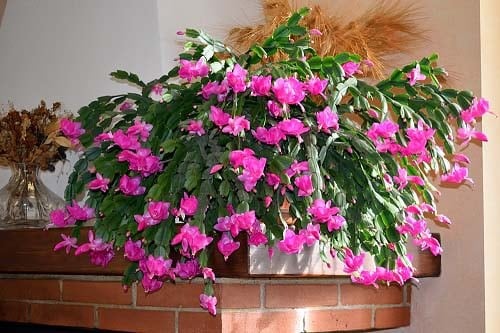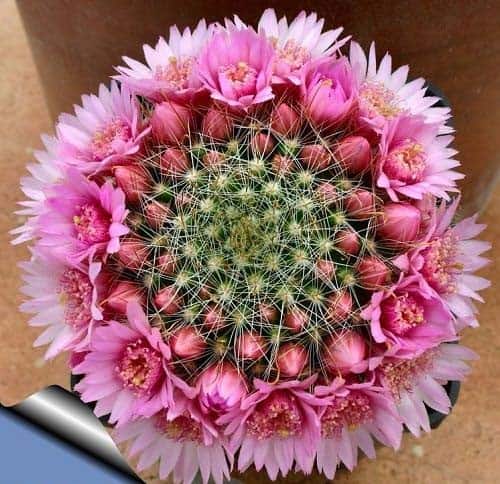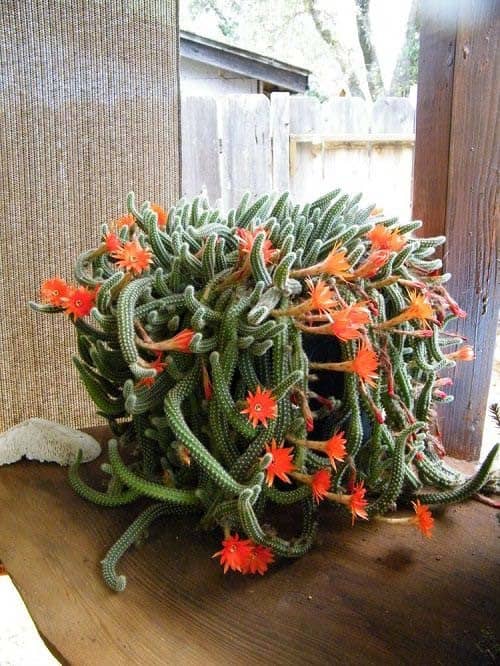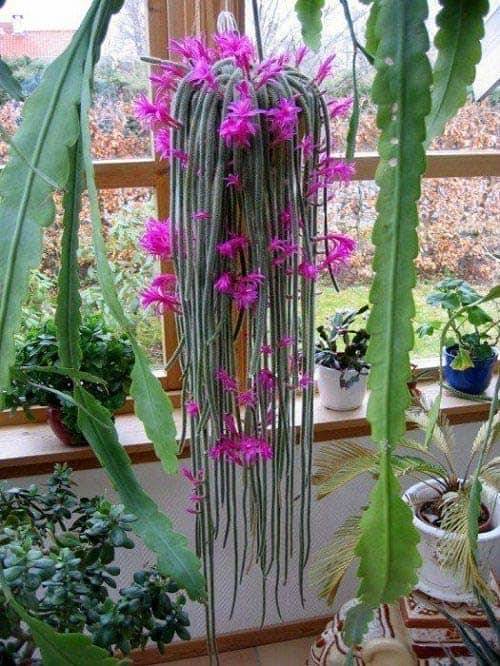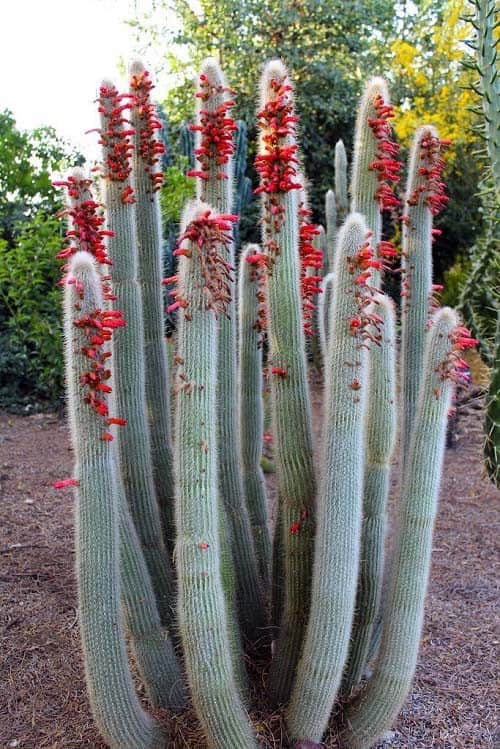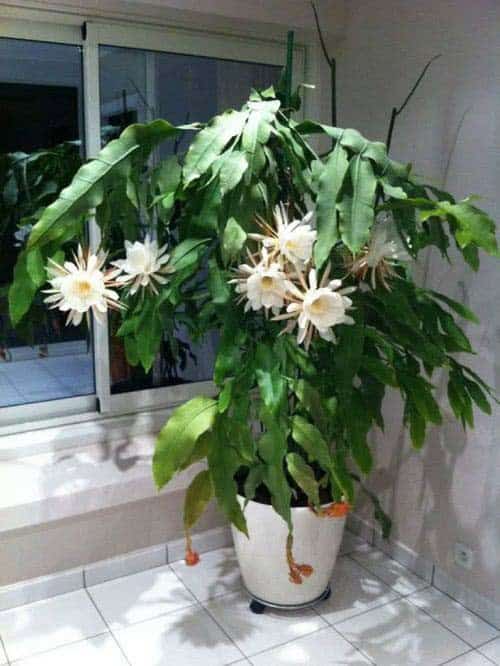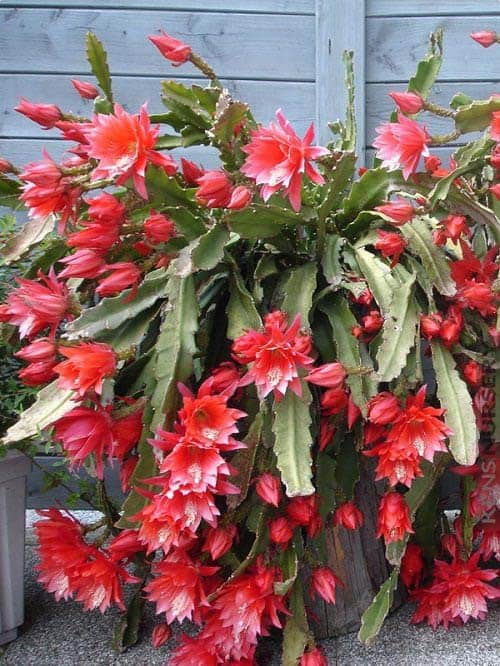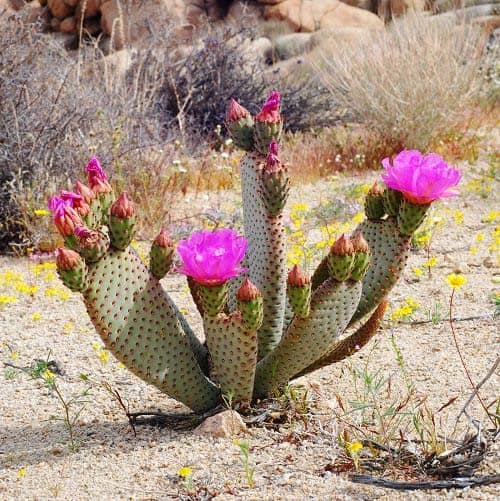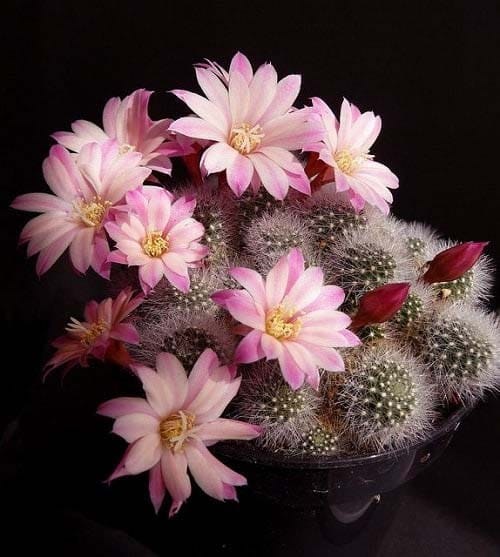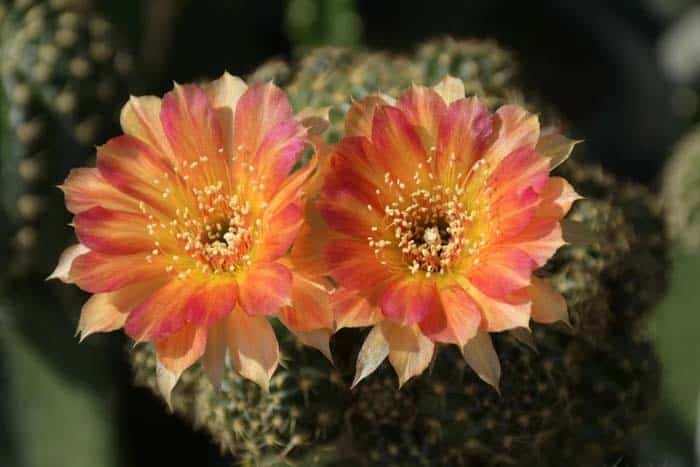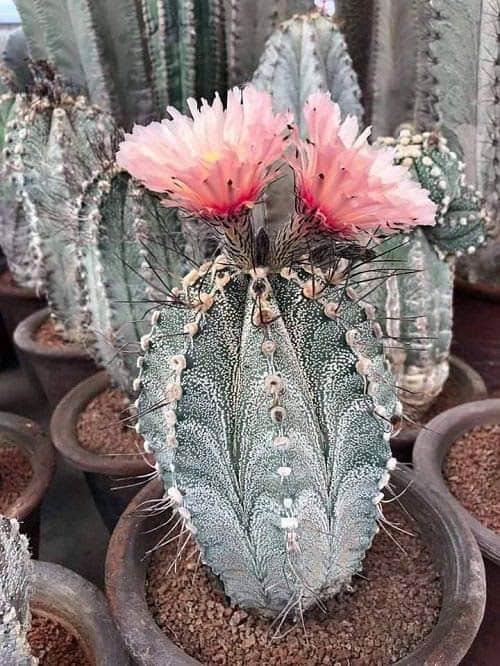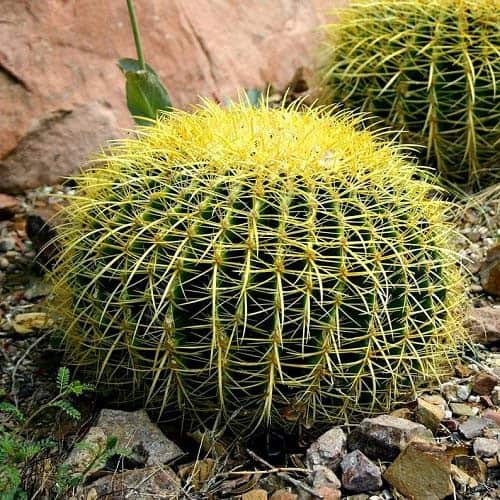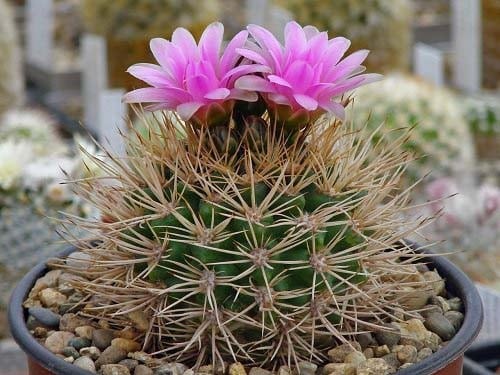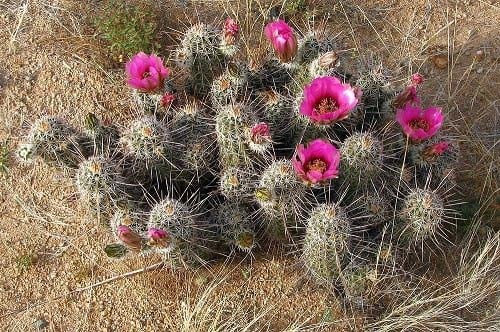While cacti are often associated with arid environments, many species have been successfully cultivated for outdoor rock gardens and indoor pots. One of the most delightful surprises is when these prickly plants bloom, transforming into a stunning focal point. The delicate flowers that emerge can be just as breathtaking as those found on orchids. With their unique shapes and unexpected beauty, cacti have become a popular choice for garden enthusiasts.
Check out our collection of Flowering Cactus Plants to see the incredible variety and get inspired by their beauty.
Bishop’s Hat Cactus
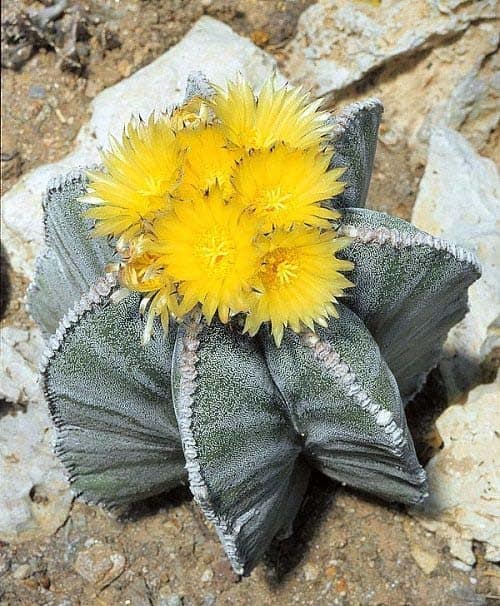
The Bishop’s Hat, a succulent native to northern Mexico, thrives in limestone habitats at elevations between 1500-2000 meters. Its striking appearance is characterized by the sculptural arrangement of its ribs, accentuated by white, curved scales that provide a unique visual texture.
When it blooms, the cactus produces bell-shaped yellow flowers that emit a pleasant fragrance, adding to its allure.
While relatively easy to cultivate, the Bishop’s Hat does have some specific growing requirements, including patience – as it matures slowly – and caution, as it is prone to rotting if not properly cared for.
Botanical details: Astrophytum myriostigma; flowering season: summer.
Old Lady Cactus
The Old Lady Cactus, scientifically known as Mammillaria hahniana, is primarily found in South America, the southern regions of North America, and areas with arid climates. One of its most distinctive features is its oval shape, making it a visually appealing cactus. Notably, it’s considered one of the simplest flowering cacti to cultivate, thriving in sunny spots within homes or offices.
Mammillaria hahniana boasts small pink blooms during the spring and summer seasons.
Like most cacti, it has a fondness for well-lit areas but also requires regular watering during the summer months.
Fairy Castle Cactus
The Fairy Castle cactus, with its unique five-sided stems covered in woolly-based spines, is a charming addition to any indoor space. As it matures, the plant develops branching stems that eventually take on an intriguing shape. Like all cacti, this species thrives in full sun and well-drained soil conditions. While blooming is rare for the Fairy Castle, it’s fascinating that the large white flowers typically bloom at night during the spring and summer seasons.
After about ten years of growth, this delightful plant will reward you with its nocturnal displays.
Starfish Cactus
The Starfish Cactus (Stapelia) thrives in tropical and subtropical regions, often cultivated indoors due to its unique characteristics. Its segmented stems, measuring approximately 10 cm in height, are spineless and robust. The plant’s showstopping flowers take the form of perfectly symmetrical five-rayed stars, boasting a striking green and yellow coloration.
A peculiar aspect of this cactus is its ability to emit a strong odor when blooming, which attracts an abundance of insects crucial for pollination. This distinctive trait highlights the importance of insect interaction in the plant’s reproductive cycle.
Notably, the Starfish Cactus does not tolerate direct sunlight, especially during scorching summer days. Prolonged exposure to intense solar radiation may cause damage to the plant.
Instead, it prefers a partial shade environment that mimics its natural habitat.
Easter Cactus
The Christmas cactus, Schlumbergera truncata, is a stunning addition to any indoor space. Its unique stems cascade downwards, flat and measuring 4-6 cm in length. The ends of these stems are notched, rather than sharply edged, creating the perfect stage for the vibrant flowers that bloom here. These flowers come in a range of colors, including red, orange, pink, and white, and are renowned for their long-lasting beauty during the cold winter months.
It’s no wonder this cactus is one of the most popular choices for indoor cultivation, with its rich flowering period that lasts throughout fall and winter.
Balloon Cactus
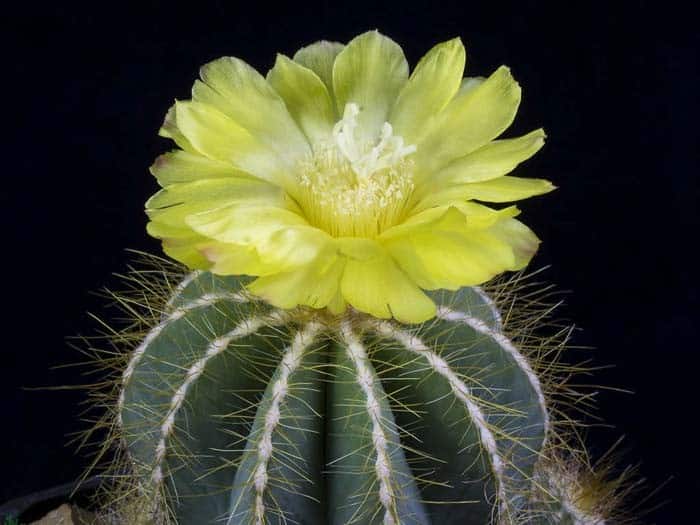
The Ballon Cactus, also known as Notocactus magnificus, is a remarkable species that thrives in its natural habitat. Its impressive growth habits make it relatively easy to cultivate, and its stunning blooms are a true marvel. Interestingly, this cactus has been listed as a protected species in the International Red Book, highlighting its importance in the conservation efforts.
Typically found in cool, dry fields up to 800 meters above sea level, the Ballon Cactus requires a specific environment to flourish. When temperatures drop, it’s essential to bring this succulent indoors to ensure its survival. When it blooms, the Parodia produces two large, vibrant yellow flowers with shimmering petals, making it a true showstopper. Its flowering period typically occurs during the summer months.
Schlosser Cactus
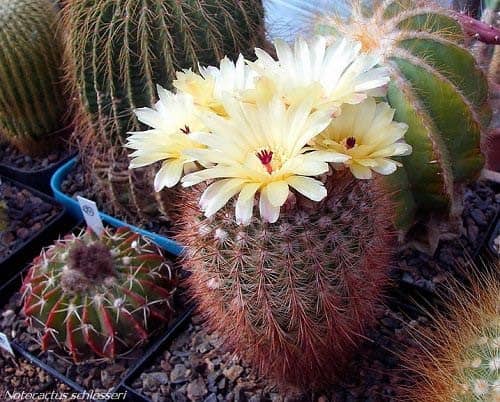
The Schlosser Cactus, scientifically known as Notocactus schlosseri, is a unique species that boasts a singular stem with a short cylindrical or spherical shape. As the cacti mature, they can grow up to 1 meter in height, characterized by ribbed and dark green stems. A notable feature of this species is the presence of spines in shades of red and yellow at the top part of the ribs.
The crowning glory of the Schlosser Cactus is its vibrant flowers, which appear at the top of the stem and take on a bell or funnel shape. The colors of these blooms range from orange to red to yellow, providing a stunning display during the summer flowering season. Unfortunately, this fleeting beauty has a lifespan of just 7 days before it fades away.
Rosy Pincushion Cactus
The Rosy Pincushion Cactus (Mammillaria zeilmanniana) is a small, yet striking species native to Mexico. Its glossy green stem can take on either a spherical or oval shape, reaching heights up to 12 cm and diameters of approximately 8 cm. One of its most notable features is the concentration of funnel-shaped flowers at the top of the cactus. These pale violet blooms are around 2 cm in diameter, adding a touch of elegance to this diminutive yet charming plant.
Interestingly, the Rosy Pincushion Cactus can produce flowers at any time throughout the year.
Lincoln Gem Cactus
In Argentina, this diminutive cactus is native, yet its name originates from ancient Greek. Chamai, meaning ‘creeping on the ground’, is a fitting moniker for a plant that thrives in low-lying environments. Measuring up to 10 cm in height and boasting stems with a slender diameter of just 1 cm, this species features lengthy branches with a characteristic light green hue.
It takes three years for these cacti to reach reproductive maturity, at which point they burst forth with vibrant orange blooms that measure 3 cm in diameter – significantly larger than the stems themselves. A brief but spectacular display, these flowers only bloom for two days before fading away. When it comes to botanical nomenclature, this species is classified as Chamecereus silvestri and typically flowers during the summer months.
Powder Puff Cactus
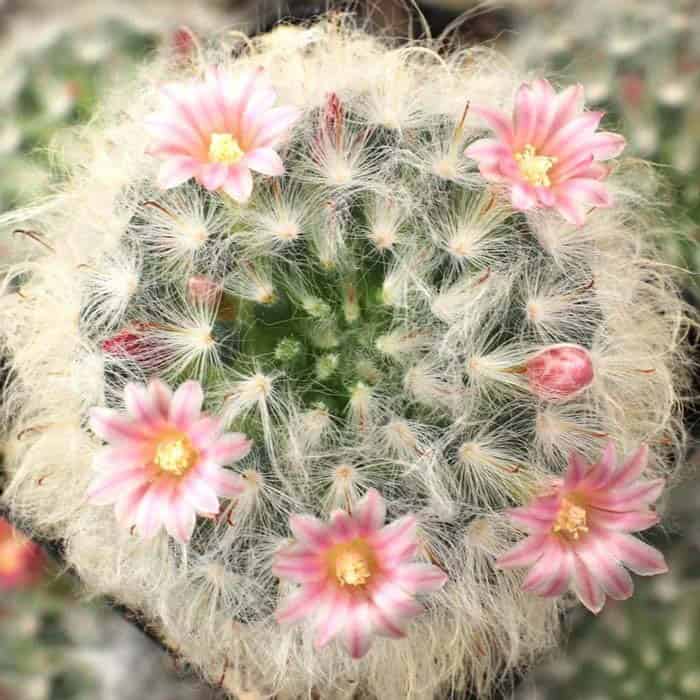
The Mammillaria bocasana, also known as the Powder Puff cactus, is a rare and protected plant species native to Mexico. Its unique appearance features a hemispherical shape covered in soft, white spines that provide excellent protection from predators. This remarkable cactus grows rapidly, producing small round offsets around its parent plant, effectively creating a miniature colony. The flowers that bloom are tiny and come in a range of colors, including white, yellow, pink, and red.
When cultivating this species outdoors, it’s essential to be mindful of the specific growing conditions, as it thrives only in zones 9b to 11b. For those outside these regions, the Powder Puff cactus can still flourish when potted and placed indoors, where it will appreciate the controlled environment.
Rat Tail Cactus
Aporocactus, a native Mexican species, can be cultivated in domestic environments with some limitations. While there are six species found in their natural habitat, only one variety, Aporocactus flagelliformis, is suitable for indoor growth. This unique cactus boasts light green stems adorned with dangling ribs and short, fur-like spines featuring a yellow-brown hue. The showstopping feature of this plant, however, is its stunning pink flowers that reach up to 7 cm in diameter.
When blooming profusely, Aporocactus flagelliformis takes on an irresistible allure. In terms of maintenance, these cacti are relatively low-maintenance; simply prune any thinned or damaged sprouts to keep them healthy and thriving. The flowering period typically occurs at the end of winter, adding a pop of color to your space during this time of year.
Silver Torch Cactus
The Silver Torch Cactus, scientifically known as Cleistocactus strausii, is renowned for its unique straight growth habit. Its slender green-grey stems can reach up to 3 meters in height, while maintaining a relatively narrow diameter of approximately 15 centimeters. The stems are densely covered with spines, giving the cactus a distinctive ‘hairy’ appearance. A notable feature of this species is its ability to produce numerous red flowers that remain closed and tubular in shape.
Interestingly, only those plants that have reached a minimum height of 45 centimeters can develop these vibrant blooms, typically towards the end of summer.
Dutchman’s Pipe Cactus
The Dutchman’s Pipe Cactus, despite resembling a water lily or orchid in appearance, is actually a member of the cacti family that showcases its beauty through nocturnal blooms. Characterized by large, white flowers with diameters of approximately 20 cm, this unique species only reveals its true colors at night. Interestingly, the stems have undergone mutations to form flat, wide, and fragile leaves that give rise to new growth from existing ones.
It takes three years for the cactus to mature and produce its stunning blooms, a treat best savored under the stars.
Orchid Cactus
The Epiphyllum hybrids or Phyllocactus orchid cacti stand out due to their unique, flat stems that droop down from the base of the plant. These succulent structures can grow remarkably long, showcasing the species’ adaptability. However, it’s the flowers that truly captivate attention. Emergeing from small notches along the stem, these blossoms produce edible fruits when pollinated.
While their delicate beauty is undeniable, the fleeting nature of the blooms means they’re enjoyed for a short time only. Summer is the ideal season to witness this botanical marvel in full bloom.
Spider Cactus
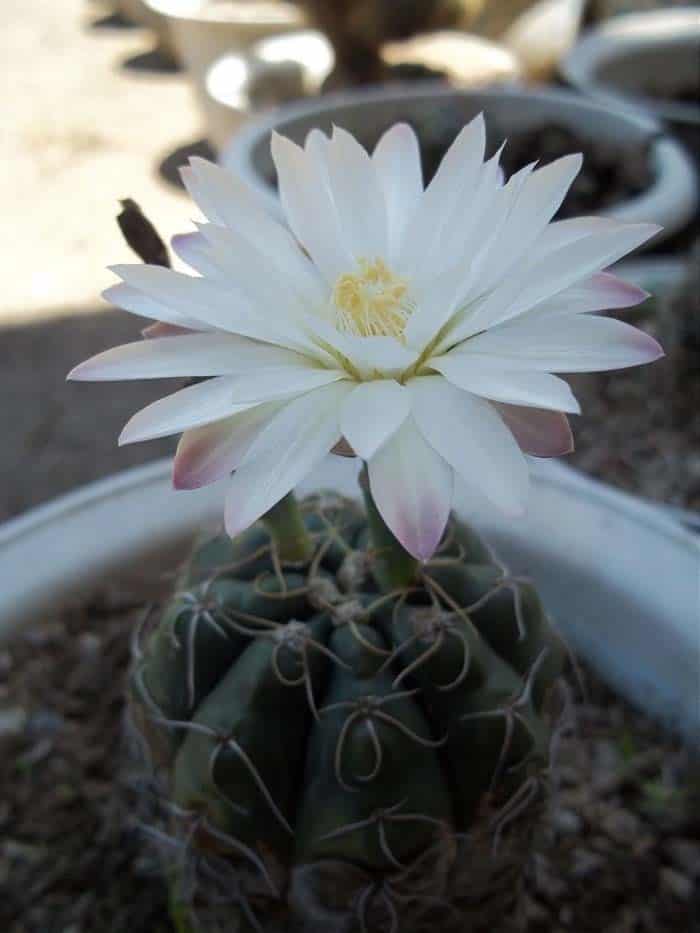
The Gymnocalycium oehmanthemum, also known as the spider cactus, owes its distinctive moniker to the delicate, curved spines that evoke the image of a spider’s legs. The plant’s stem is characterized by its glossy, spherical shape and rounded ribs. A notable feature of this species is the softness of its spines, which provide a unique texture. As one of the more straightforward cacti to cultivate, it thrives in full sun, with moderate watering and occasional fertilization.
One of the most striking aspects of the spider cactus is its vibrant flowering period, during which it produces large, creamy white blooms that can reach up to 7 cm in diameter, a true visual treat. In terms of botanical specifics, this species falls under the classification Gymnocalycium oehmanthemum, with peak blooming occurring during the summer months.
Beavertail Cactus
The Beavertail Cactus is a visually striking plant that boasts a unique combination of features. Its medium-sized stature and ability to produce vibrant rose-colored flowers make it a standout in any desert landscape. But what really sets this cacti species apart is its unique stem shape, which can grow flat and wide enough to cover hundreds of individual pads that have a beautiful blue-grey hue.
This striking arrangement makes the Beavertail Cactus an ideal addition to a rock garden or other low-maintenance landscaping design. From a botanical standpoint, the Beavertail Cactus is known scientifically as Opuntia basilaris and typically blooms in the spring to early summer months.
Aylostera Cactus
The Aylostera Cactus, scientifically known as Rebutia narvaecensis, is a compact and unique species that thrives in low-growing clusters. Its stems hug the ground, forming dense groups of branches. What’s striking about this cactus is its remarkable ability to produce large, pale pink flowers from the lower half of its stems. In some cases, the blooms are so large that they almost entirely conceal the stems themselves.
This cactus is characterized by its slow growth rate but requires minimal maintenance, making it an excellent choice for gardeners of all levels. Its adaptability allows it to thrive in both rocky outdoor gardens and indoor spaces, where it can be a captivating focal point.
Sulcorebutia Cactus
The Sulcorebutia Cactus, a ubiquitous species, boasts a unique morphology characterized by its globular and cylindrical stem, which tapers to a flattened top. A striking feature of this cactus is the vibrant, multicolored flowers that adorn its surface. Growth is slow and deliberate, with sturdy, elongated spines emerging as the plant matures.
The stem itself exhibits a range of hues, transitioning from green to grey-brown, while the root system is robust and well-developed.
Floral displays occur at the apex of the stem, forming an attractive, wreath-like arrangement.
Scientific classification: Sulcorebutia albissima
Flowering season: Late spring
Lobivia Cactus
The Lobivia Cactus, native to Bolivia, is a dwarf succulent characterized by its cylindrical stem and impressive flowers that match the size of the stem. This unique species thrives in sunny environments with high temperatures, where it receives moderate watering from March to September. During the winter months, it requires minimal watering, typically limited to once a month.
With a botanical name of Echinopsis densispina Werderm, this cactus blooms in the spring, showcasing its vibrant colors and remarkable size.
Mammillaria Cactus
The Mammillaria Cactus is characterized by its spherical, green stems that rapidly branch out to form clusters. A distinguishing feature of this species is the thick white spines that cover the stems, imparting a greyish hue. In contrast to their subdued appearance, the flowers of Cochemiea guelzowiana are striking in their bell-shaped form and vibrant purple color. This cactus blooms during the summer season.
Monk’s Hood Cactus
The monk’s hood cactus (Astrophytum ornatum) is a striking, solitary succulent that stands out with its cylindrical shape reaching 1-2 meters in height and approximately 30 centimeters in width. The plant’s surface is characterized by a unique feature: it’s covered with white flakes that provide natural protection from the sun’s intense rays.
This versatile cactus thrives in well-drained soil, making it an excellent choice for rock gardens.
It’s particularly fond of filtered light or shade and can tolerate cold temperatures as low as 25 degrees Fahrenheit, making it a great option for gardeners who live in cooler climates.
One of the monk’s hood cactus’ most notable features is its showy yellow flowers that bloom during the summer months.
Rebutia Cactus
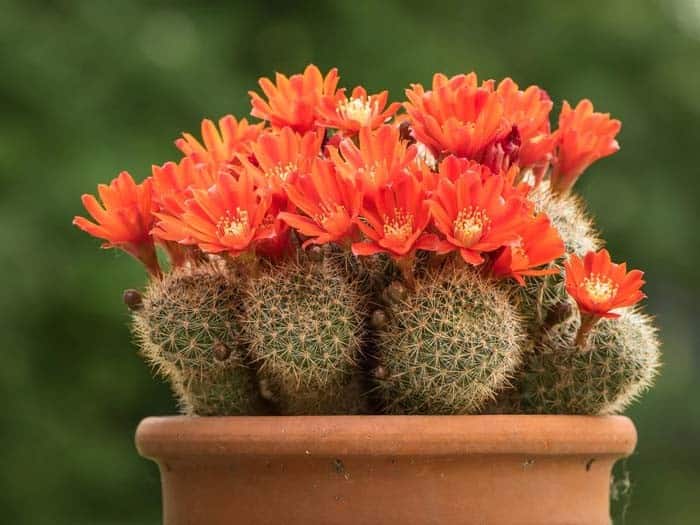
The Rebutia heliosa, or Crown Cactus, is a resilient succulent that boasts vibrant fire-orange blooms. Native to high-altitude regions with harsh environmental conditions, this cactus has adapted to thrive in challenging settings. Its slender, cylindrical stem features vertical ribs and measures approximately 2 cm in diameter, although it can grow significantly taller.
The crown-shaped flowers, also measuring 2 cm in diameter, emerge at the tip of the stem, often remaining for several weeks under optimal conditions.
Golden Barrel Cactus
The Echinocactus Grusonii, a type of swollen spherical cactus, thrives in sunny spots with well-drained soil and regular watering during the summer months. This winter-hardy plant is an excellent choice for adding a unique touch to your garden or windowsill. When mature, it produces stunning bell-shaped flowers that reach up to 5 cm in diameter. The blooms typically appear after the plant has reached a diameter of around 30 cm.
Spring is the perfect time to witness these vibrant flowers unfolding.
Chin Cactus
The Chin Cactus, scientifically known as Gymnocalycium neuhuberi, is a stunning species from Argentina. It thrives in elevated regions between 800 and 1550 meters above sea level. One of the most striking aspects of this cacti family member is its breathtaking lilac blooms, which also emit a fragrant scent. A distinguishing feature of the Chin Cactus is its solitary, matte green stem that is spherical in shape.
In addition, it sports straight needle-like spines that provide an unmistakable visual cue. As for blooming time, this species typically produces its stunning flowers during the summer months.
Strawberry Hedgehog Cactus
The Strawberry Hedgehog Cactus, Echinocereus engelmanii, is a unique plant that thrives in clusters with up to 20 stems. This striking cactus is often used as a landscape feature in its native habitats and can also be found in pots across other regions. One of its defining characteristics is the presence of small stems covered in thick, heavy spines.
The real showstopper, however, is the stunning display of funnel-shaped flowers that bloom at the upper half to one-third of each stem.
These vibrant blooms come in a beautiful magenta color and can be enjoyed during the summer months.
Peanut Cactus
The peanut cactus, a popular choice for cascading succulent gardens, boasts an unique appearance. Its slender, finger-like stems are adorned with soft spines, gradually forming clumps that create a charming display of layered foliage. The name ‘peanut’ originates from the resemblance of new sprouts to peanuts. Notably, this cactus lacks the ability to photosynthesize, necessitating strategic placement over other cacti to ensure its survival.
When it comes to botanical classification, Echinopsis chamaecereus is the scientific name for this species, which typically blooms during the summer months.
